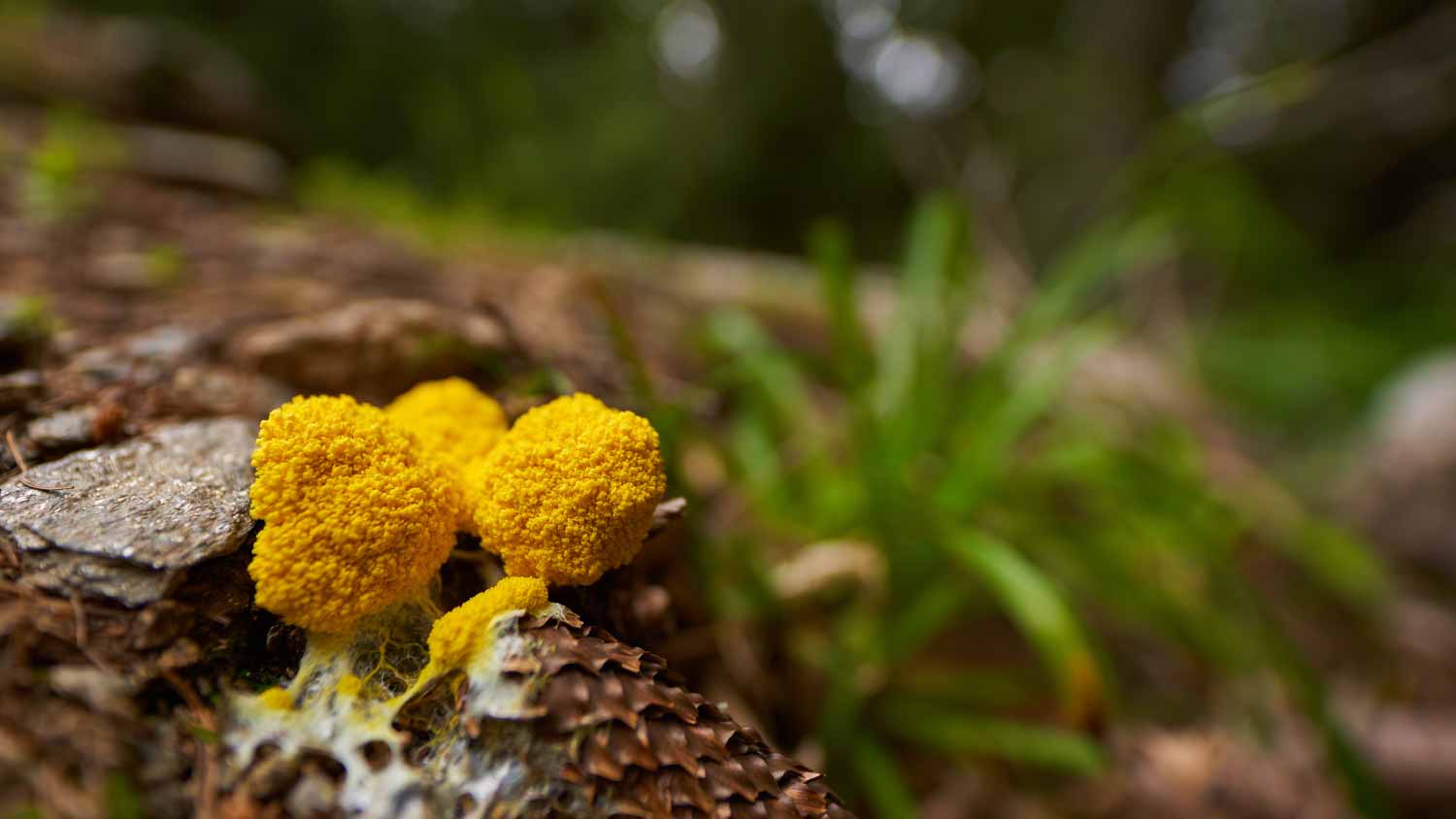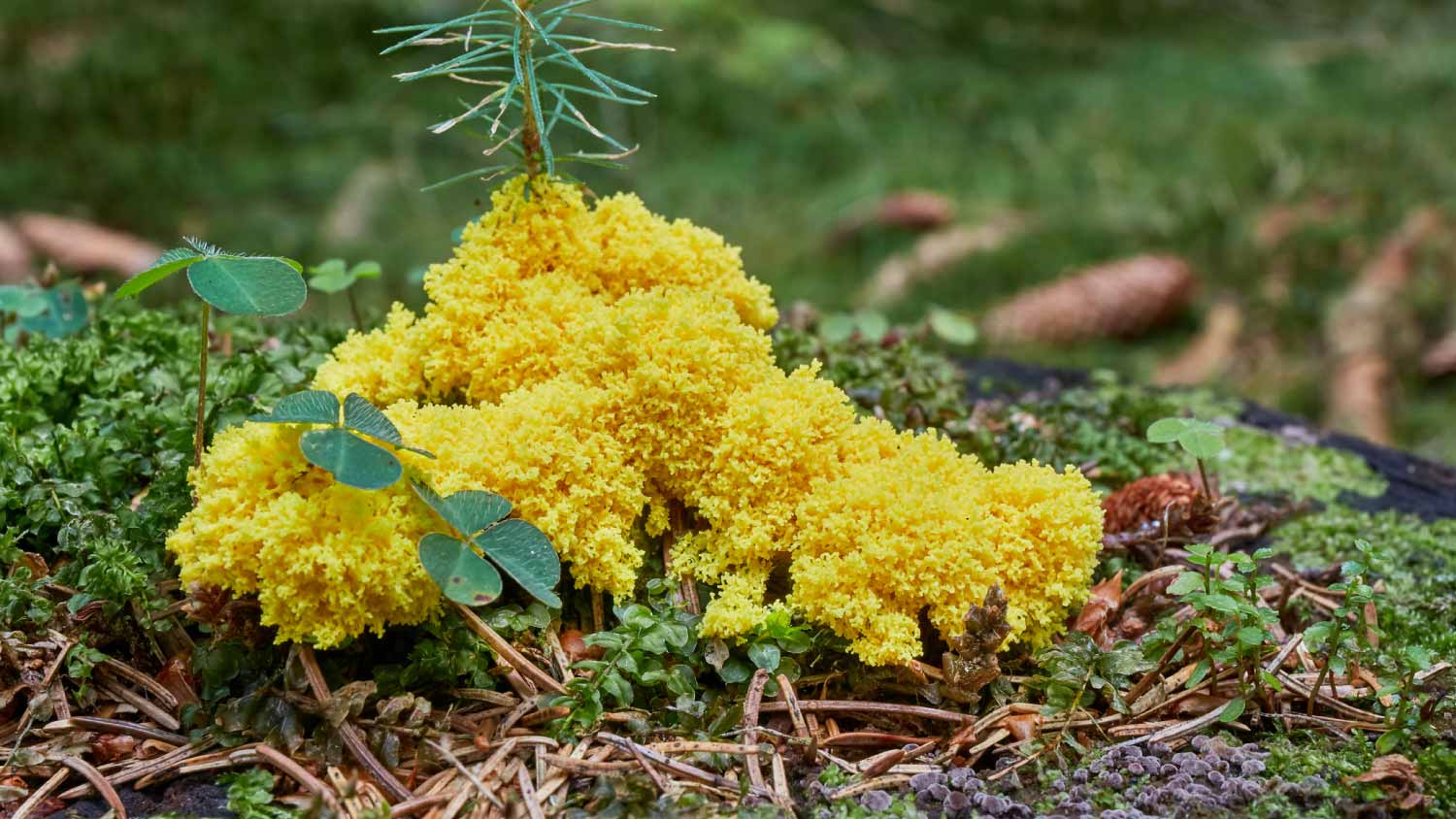
Removing an old lawn is often necessary to plant new grass or build a new outdoor structure. Find out what to budget for your lawn removal cost.
Remove this unsightly, brightly colored nuisance from your yard in a few easy steps


Professional mold remediation costs $10 to $25 per square foot, but it ensures the job gets done safely and efficiently.
Pros can identify whether you have slime mold or another type of fungus or bacteria, ensuring the right treatments are used.
They have access to safe, targeted removal methods that eliminate mold without damaging your lawn or posing an ingestion risk to your pets.
A local lawn care pro or mold specialist will prevent regrowth by addressing underlying moisture, soil, or organic matter issues.
There’s no doubt about it: Dog vomit slime mold is an unsightly visitor in any yard with its foamy texture and bright yellow presence. While harmless, this mold is still unwelcome in many yards. This guide will cover what is dog vomit slime mold, and how to get rid of it.
Despite its alarming name, dog vomit slime mold (Fuligo septica)—which is not toxic to humans, plants or pets—is more of a cosmetic nuisance than a worrisome concern. Sometimes called “scrambled egg mold,” dog vomit slime mold usually manifests in the form of a wet, bright yellow blob on moist surfaces. This type of mold, sometimes mistaken for a fungus, feeds on decaying organic matter. So, while ugly, it can have positive benefits in some gardens and ecosystems.
Dog vomit slime mold has a bold, unmistakable look. Typically, in its early stages, the mold will appear with a frothy or spongy texture and a bright yellow color. Some have likened this mold to scrambled eggs. It usually grows to about 8-inches wide with a height of 1 1/4 inches. Unlike white mold on plants, dog vomit slime mold prefers damp, dark areas. As the mold matures, the substance dries and hardens, transforming into a dark tan, brown, or black color.

Most experts advise against using chemicals to kill dog vomit slime mold. This how-to guide will focus on the steps you can take to manually get rid of dog slime mold in your yard.
As a quick removal option, you can scrape off dog vomit slime mold with a small shovel. This is often effective for mold growing along tree stumps or on lumber stored in your yard. If you choose to scrape off the mold, keep in mind that this action can release the spores from its current growth spot, potentially causing the mold to spread to nearby areas.
It might seem simple, but raking the area is one way to get rid of dog vomit slime. This process will break up the mold and expose it to fresh air, which will dry it out and quell the spread. Mold spores can spread through the wind, so you might want to save this for a day when the weather is dry with limited wind.
Dog vomit slime mold loves dark, moist areas, so creating a drier space will eliminate dog slime mold from growing and spreading. If you’re seeing pockets of a frothy, bright yellow substance, cut back on your watering schedule for a few days. If you have an irrigation system in your yard, adjust the timing and frequency of waterings until the mold growth has stopped. Chances are, your yard will be fine without faithful waterings for a few days.
Using a water hose to break up dog vomit slime mold can stop it from spreading. Stay away from powerful nozzles that produce a strong stream of water. This can cause the mold to spread to nearby vegetation, potentially multiplying your problem. Once you’ve lightly hosed off the mold, rake over and around the area to expose it to sunlight and air.
Consider pruning plants and trees to give your lawn more direct sunlight. You may find dog vomit slime mold at the base of large trees because shaded areas tend to hold on to moisture longer. By decreasing the amount of shade in your yard, you’re curbing the growing conditions that cater to dog vomit slime mold. Depending on the size and numbers of trees, you may want to DIY pruning. Tree-trimming costs can range between $400 and $800 per tree when hiring a local landscape professional.
Decomposing wood is the equivalent of an all-you-can-eat buffet for dog vomit slime mold. Slime molds feed on decaying organic matter, meaning you may find it in places such as untreated lumber, leaf litter, and rotting logs. You may also find it in mulch. If you’re tired of seeing dog vomit slime mold, try removing some mulch to see if that quells some of the mold growth.

Dog vomit slime mold thrives in moist, shaded areas on decaying organic matter, such as mulch and rotting logs. It might not be possible to completely prevent dog vomit slime mold, depending on your local climate. But there are some things you can do to dissuade it from growing and spreading.
If you use mulch, stir it up often to break up any plasmodia, and dry out the area.
Consider using something other than mulch in your yard, such as cedar bark, pine straw, or gravel.
Avoid excessively watering your lawn—especially if you have a lot of shade.
When humidity levels are high, rake over the areas of your yard that are prime for dog slime mold growth every other day.
Aerate your lawn to reduce the humidity, loosen compacted soil, and let in air.
Dog vomit slime mold will usually disappear on its own after a few days to weeks. Experts caution against using chemicals to kill the mold, as it can cause issues for other vegetation in your yard. Taking a DIY approach to removing dog slime mold will save you money but cost you time.
However, if you choose to hire a local lawn care service to tackle this unsightly mold, the cost to get rid of dog vomit slime mold can vary based on a lawn care pro’s pricing chart. It can cost between $0.10-$0.35 per square foot to have a lawn care professional aerate your lawn, which can help prevent dog vomit slime mold growth. The national average cost for lawn aeration for a 10,000-square-foot yard is around $139. Keep in mind: This might be a service that some pros add to a service like lawn mowing.
From average costs to expert advice, get all the answers you need to get your job done.

Removing an old lawn is often necessary to plant new grass or build a new outdoor structure. Find out what to budget for your lawn removal cost.

How much it costs to rent a lawn aerator depends on what kind you rent and how long you rent it for. Read on for the full details.

The cost to reseed a lawn can vary depending on the size of your yard and the condition of the soil. We’ll help you figure out the true cost of reseeding or overseeding your lawn, along with whether or not you should hire a professional.
Fertilizer burns can result in discolored or dead grass. These nine tips will help prevent lawn burn and keep your yard looking healthy and green with fertilizer.

A bumpy, uneven lawn can create a safety hazard, impede water drainage, make mowing difficult, and more. Learn how to level a lawn and when to call a pro.

How does your garden grow? With these nine tips for raised beds, they’re sure to be elevated—both in height and quality.